Back when we used to run the 10,000 Birds ID Clinic (as opposed to just answering lots of e-mails about bird identification!), we received an inquiry about a bird “about the size of a small duck, much bigger than a jay… a crest similar to a jay or a roadrunner and it has a remarkably long neck.” The querent included many other details about location, coloration, and what not but once I heard about that neck, one bird sprung immediately to mind… Green Heron! And wouldn’t you know it, I was right.
The Green Heron (Butorides virescens) is a spectacular species familiar to anyone who pays attention to the places where water meets land. There are so many impressive aspects to this handsome heron. One could dwell on how convoluted its family tree is… the Butorides complex, as it’s called, is surprisingly complex. While Butorides spans the globe, it is either recognized as a single species called Green-backed Heron or as three distinct species, the aforementioned New World heron B. virescens along with the Old World Striated Heron (B. striatus) and the slate-gray Lava Heron (B. sundevalli) of the Galapagos. In either case, green herons are silly with subspecies, which may themselves eventually be recognized as full species.
If taxonomy isn’t your bag, you may be impressed to learn that these striking herons are among the few tool-using birds, employing a variety of baits and lures like crusts of bread, insects, and feathers and then lurking motionless in wait for prey to attack the bait.
Still, for me, it’s all about the neck…
Corey’s recent post recounting Jamaica Bay in June includes a sweet shot of a heron sipping sinuously while perched in hanging branches. Watching green herons deploy that impossible neck is always a shock, but never more so than that first time one sees it since this bird usually adopts a hunched, short-necked profile. Here is a green heron (of the subspecies B. virescens bahamensis if you’re keeping track) in its usual stance:
Here is the same bird at full extension:
Pretty cool, huh? That is a lot of neck! The combination of pine green and rust red isn’t bad either. Let’s do that again…
As I said, the green heron is hardly rare. No matter where you live, you stand a decent chance of spotting one fishing along a fresh- or saltwater bank, particularly in summer.
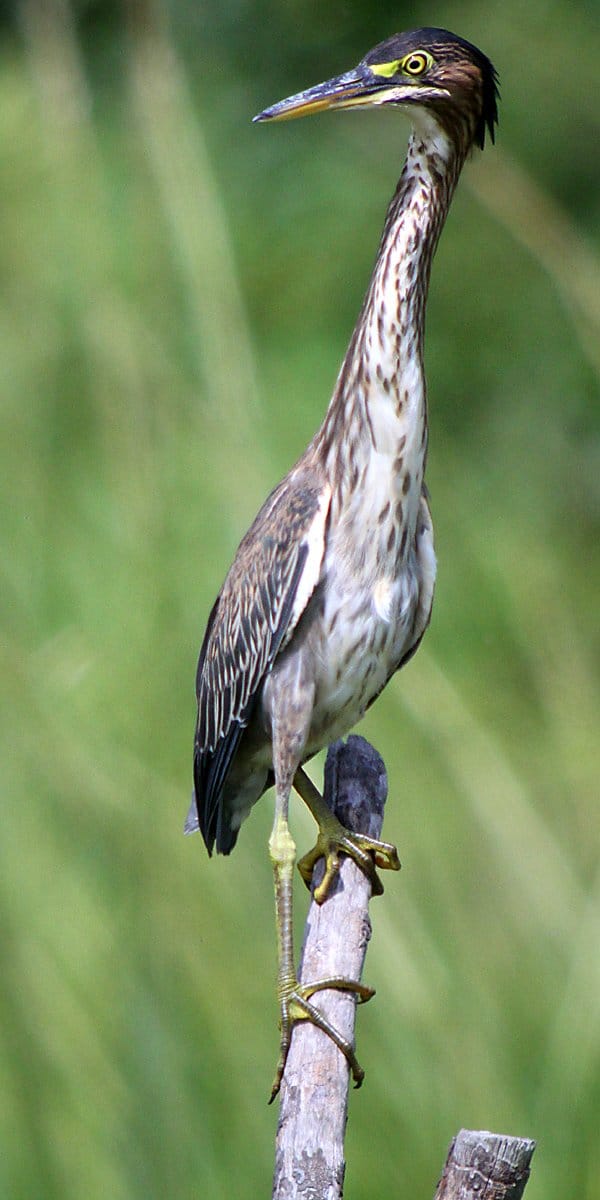
If you manage to catch a great photo of a green heron doing something impressive with its neck, or if you already have such a shot, I invite you to share it with me (mike AT 10000birds DOT com) and I’ll add it to this post. The world needs a gallery devoted to green herons and their groovy necks, wouldn’t you agree?
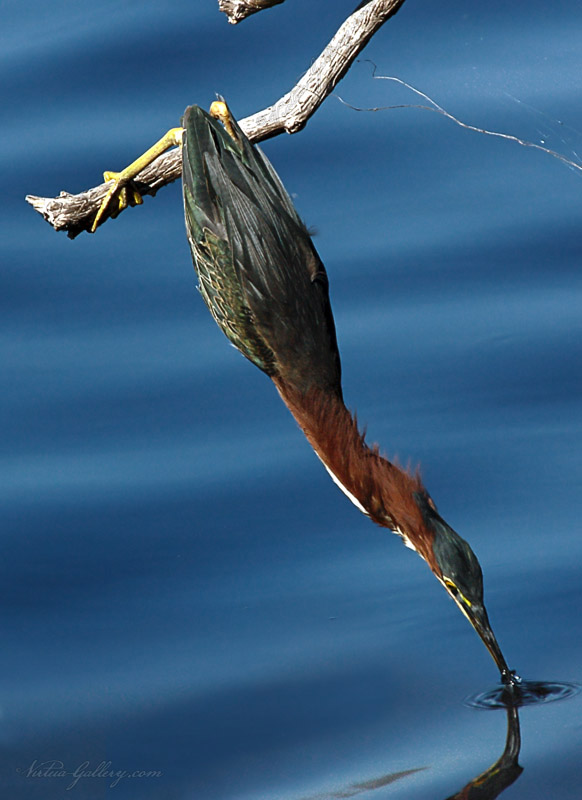
Klaus rose to the occasion with this Green Heron fishing
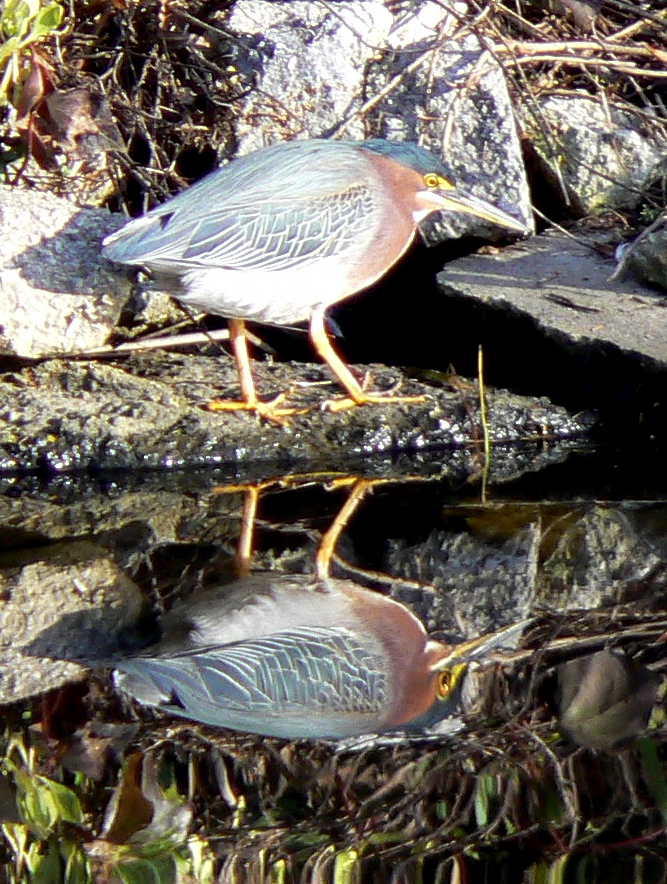
Liza Lee‘s heron is waiting to pounce


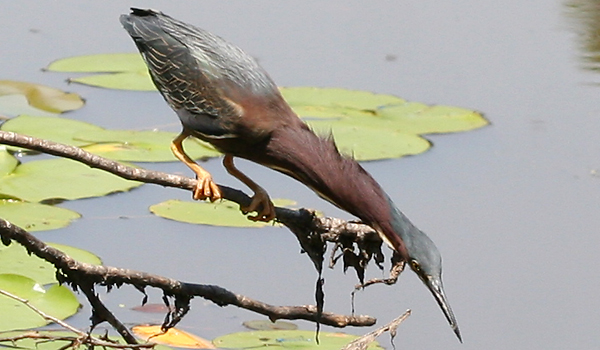
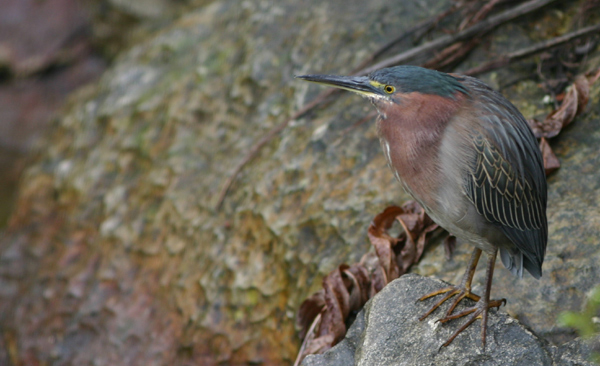
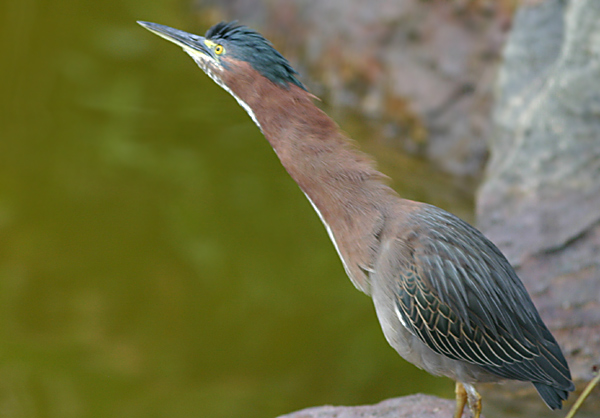
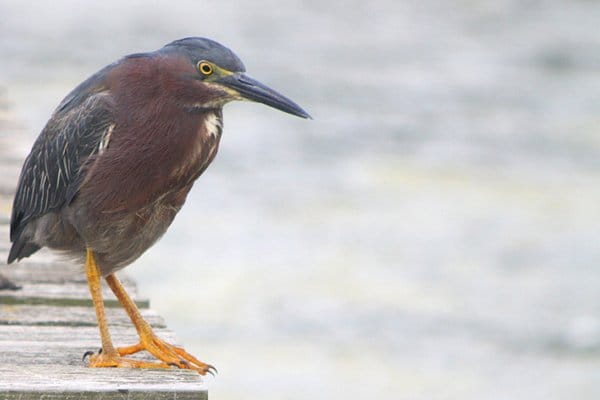
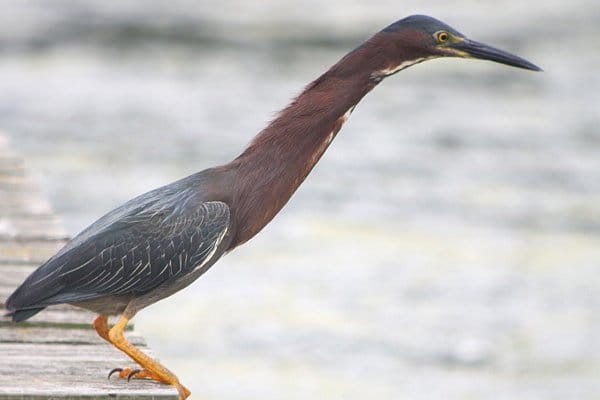











I agree! A whole gallery on these birds would be great. The first time I saw one, the stretched neck as it grabbed a fish did exactly as you said–shocked me. And the colors…
Good one! One of my favorites. Cheers, Klaus
A gallery of this species is a good idea. And Klaus’s photo is great!
These really are some neat herons. I used to have a favorite spot where a pair of them hunted frequently. They got quite casual about my and my husbands presence and would stalk around doing their thing on one side of the creek while we sat and watched them from our side. So we got to see quite a bit of their behavior. I would love a whole gallery devoted to them 😀
I initially found it hard to believe they were the same birds. A gallery would be great.
The yellow crowned night heron also has a pretty groovy neck!
There are other small herons like the night heron, but the green heron is the only bird I’ve ever seen that will hang from a branch with its feet to fish in the water below. It’s quite a sight. There are other small herons like the night heron, and maybe they can hang from their feet, too — I’ve just never seen them do it. I love green herons, wish I could see more of them, but they’re hard to spot and seem to prefer remote little streams that are hard to get to. They also have different personalities, some don’t mind a photographer bothering them, others get indignant right away and won’t let you come even within good zoom range.
Ahhh–swooning with jealousy! I’ve gotten shots of the black-crowned night heron in this area (Yokohama, Japan), but not the Striated Heron (B. striatus) yet! They *are* here, though, according to my field guide….grrrr!
Wish I had a better picture up, but my most recent post recounts seeing the heron’s stretching neck for the first time. What a thrill!
I agree–it’s all about that neck.
Thanks for this cool post!
I can’t do the before and after pair, but if you want an African example, there a rather cute on on my blog here: http://weaversandwhatnot.blogspot.com/2011/02/lake-duluti.html you’re welcome to include!
Great neck pictures and super blog. Congratulations to Klaus also!
Green Herons are my favorite bird, and that neck is lovely:
http://sienel.net/myphotos/main.php?g2_itemId=18655
Least Bitterns have a pretty fantastic neck as well (poor photo, impressive reach):
http://sienel.net/myphotos/main.php?g2_itemId=17722
A few years ago my friend and I stopped beside Bass Lake in northern Indiana; there was a large stand of milkweed and he was searching for evidence of Monarch butterflies. I wandered over to the lake edge where a little dam was built to control the flow of a stream that exit from it. Perched atop the dam was the most amazing bird with a a long bill and greenish feathers glinting in the sun, bobbing up and down like one of those toy birds that perches on the edge of glass. Each time it rose it had snatched a silvery minnow that soon was dispatched. As there was nearly a constant flow of minnows sliding over the dam, the bird was in seventh heaven, and must have gobbled several dozen as we watched, enthralled, for perhaps 20-30 minutes. Neither of us had ever seen this bird before, but a search through several bird books and websites convinced us it was the so-called “common” green heron. We’ve not seen one since! And now this! We had no idea these creatures had such amazing necks; our guy had no need to exert himself to eat his fill, so he remained, to all appearances, a short-necked bird.
I live in Port St Lucie, FL 34953 on the bank of a large canal. Some small oaks and Brazilian Pepper trees grow next to the canal on my property. A family of green herons live in the trees. I have managed to get some pictures of them, including an adult with full neck extension.Also captured a flock of Swallow tail kites today soaring above my house about 7 PM.
Great comparison photos – thank you so much!
WOW! Just had one of these in our small garden pond. It stood on the side for a short time, then suddenly grabbed a frog. It kept dipping the frog in and out of the pond for several minutes (thankfully none of our koi or goldfish fell for the trap) and then swallowed the frog, head first in one gulp. Gorgeous bird!!
Does anyone know how large a fish an adult green heron can swallow? I have been having one visit my garden pond and hope that he will thin out my over population of large goldfish. Do you think they can swallow a 6″ fish?
A six-inch fish would be easy for a Green Heron to eat. Looks like you’re in luck!
it is pleasure to watch those photos
Hello there, You’ve done an excellent job. I’ll certainly digg it and personally recommend to my friends. I am sure they will be benefited from this web site.
Hey there, You have done an incredible job. I’ll definitely digg it and personally suggest to my friends. I am confident they’ll be benefited from this web site.
I’d like to find out more? I’d like to find out some additional information.
Greate post. Keep posting such kind of information on your page. Im really impressed by your site.
Hey there, You’ve performed an incredible job. I’ll certainly digg it and in my opinion suggest to my friends. I am sure they’ll be benefited from this web site.
Awesome page and awesome bird you’ve chosen to highlight! I live near NC State Fairgrounds and there is a large pond on the premises. Driving down a small side road over there, I once saw a Green Heron standing right at the road’s edge (by the horse show area), as though waiting for traffic to pass so he could cross to the pond side. I had never noticed any Green Herons at the pond before, so was thrilled to spot him! Sure enough, in my rear view mirror, I could see that he walked across the road the minute my car had passed! I’ve often wondered: why didn’t he just fly over there?? 😀